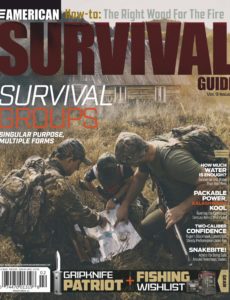
American Survival Guide – February 2020
English | 101 pages | pdf | 48.53 MB
can’t speak for everyone, but I think there is a certain amount of optimism that makes up part of the mental image, and ultimately our plans, for the types of challenges we might be subjected to and the environments we’ll be forced to deal with in those situations. While we typically see ourselves as prevailing, which is good, I think there is something missing that could work against us.
Despite the fact that my work is heavily dependent on words, I’m more of a visual person when it comes to learning, retention and planning. Give me a good book or an insightful pdf magazine
article (see 13 of those in the coming pages), and I probably won’t retain much of what I read unless there are some good images to reinforce the plot or topic. But, if I watch a movie or TV program, chances are I’ll retain a lot more of what I saw. So, when I consider and plan out what I need to be prepared for, it goes through my head like a series of movie clips that take place in assumed settings, which are almost always sunny and dry. Generally, I’ve rarely thought twice about the macro aspect of those settings; things like weather, the season and the time of day.
Of course, if the threat du jour is a flood caused by the creek behind my house, the setting is during one of our rainy seasons, but the non-weather-related run-throughs in my mind usually take place on dry earth and sunny days, which is the point I’m getting at. Many, if not all, of my plans will change by simply adjusting the settings from day to night and dry to wet. I need to do a better job of planning through scenarios that take place in all sorts of conditions, and you may too. For example, what if that flood occurred in the dead of winter? Sure, in North Georgia chances are not great for that but neither were they for the “once-in-1,000-year” flood we had in the late summer of 2009, but it happened.
I was thinking about this planning error when Christopher Nyerges suggested a couple articles about important and underrated nighttime skills: navigation and telling time. His piece on navigating by the stars appeared in our January 2020 issue, so you might want to pick that one up if it’s not part of your collection. Yes, there’s a bit of science to it, but it’s like walking through the front door of a bakery to work in the kitchen. The process he takes you through involves some beautiful scenery and may give you pause to appreciate the nighttime sky a little more as you learn to find your way in the dark. In this month’s issue, Christopher explains how to tell time with the help of many of the same stars and constellations he discussed in his navigation piece. That makes it a good opportunity to refresh learnings from the previous article as you work your way through the new one. This month’s article appears at the end of this American Survival Guide Magazine issue, and we’ve included a page you can cut out to help you construct the star dial he describes. If you don’t want to cut it out, you can easily scan or copy it and keep your magazine intact. For those of you who rarely venture out at night, Christopher also explains how to build an accurate compact and portable sundial in another article this month.
We hope this winter won’t last as long as it did in many parts of the country last year, so we’ve included some topics you should start thinking about as you prepare for spring. But if winter lingers on, you can reference useful cold-weather information on our website, ASGMAG.com, where our archive has grown to more than 800 articles.
While you’re online, be sure to sign up for our free weekly Newsletter and check out ASG’s Facebook page — facebook.com/pg/americansurvivalguidemagazine — and Instagram page — instagram.com/
asgmagazine.
All the Best!
—Mike McCourt
Brand Manager
Download from: